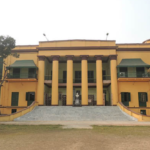The year 1851, regime of East India Company – cholera epidemic broke out in Uttarpara and its surrounding areas. The then Zamindar, Babu Joykrishna Mukherjee and other residents of Uttarpara tried hard to tackle the disease. The epidemic subsided but left Joykrishna thinking – how to stop recurrence of such scourge in future ? Progressive and forward looking – as was Joykrishna, immediately understood the value of modern sanitation system and need for germ free drinking water. And who else can ensure these community health standards other than a civic body ? Natural thinking, one would say today – but it was a tremendous step forward in mid Nineteenth century Bengal !
Towards the end of 1851 – Joykrishna and others appealed to then Govt of Bengal for setting up a Municipal Authority for Uttarpara. However, their appeal was rejected as a section of villagers opposed the move. Subsequently their second appeal was accepted after majority of residents understood its true potential and agreed. Thus was born Uttarpara Municipality – only the second town in Bengal to voluntarily adopt the Municipal Act of 1850 Sec XX16 (remember, Bengal in those days included Bihar and Orissa also – a vast territory larger than England, Scotland and Ireland put together). It would not be out of place to mention that Serampore, which was the first town to adopt municipal act, did so because of its European residents who forced its adption against the wishes of native people. Unlike Uttarpara – Serampore Municipality used to be managed by Europeans during its early days.

The first meeting of the nominated board was held on 14th April, 1853 at Govt. Hospital building with the following members.
Mr. G Bright, Joint Magistrate, Serampore-
PresidentBabu Jaykrishna Mukherjee Member
Babu Harish Chandra Bannerjee Member
In 1856 the board was expanded with another four members
Babu Bejoy Krishna Mukherjee, Babu Gobind Chandra Mukherjee, Babu Jagabondhu Bannerjee and Babu Taraknath Chatterjee.
Uttarpara Municipal area was demarcated as follows: Ballykhal as its Southern border, River Ganges (Hooghly river) on the East, Railway line on the West and Bhadrakali town as North border. Total area of Uttarpara Municipality was one and half sq. miles.
In 1862, 10 years after its inception, Uttarpara Municipality was superseded for 2 years over litigation on Tax charging. In the year 1864 Govt restored the authority. After long 29 years Govt. nominated Babu Bejoy Krishna Mukherjee as the first Indian Chairman of the Municipality. Nominated Boards continued from 1853 to 1884. As per Act III of 1884 – the Municipal area was divided into 4 wards with 2 members from each ward. The Municipal Board consisted of 2/3rd elected members and 1/3rd nominated by government. The life of the Board was fixed at three years. After independence, nomination system was abolished in 1948.
More Information: Uttarpara Municipality Website




